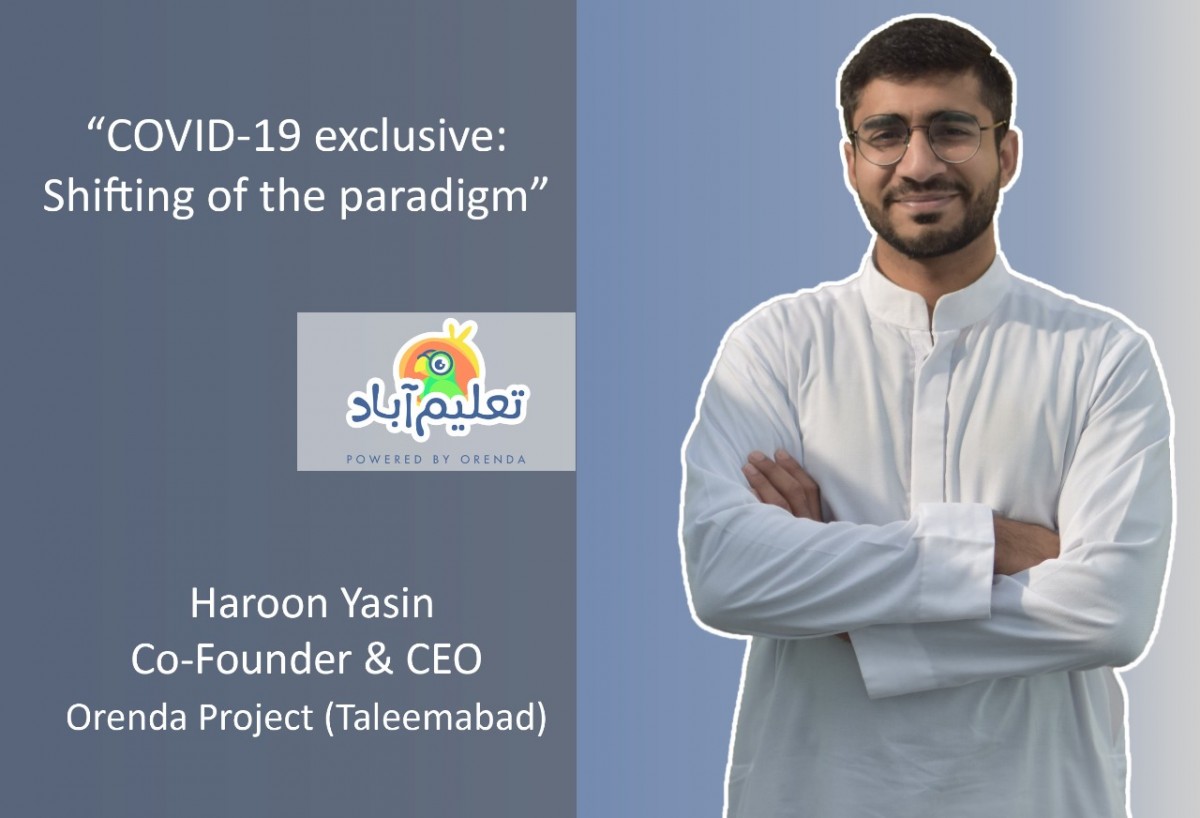“The pandemic has changed people’s attitude towards digital education, not just in Pakistan but all over the world” said Haroon Yasin, Co-founder & CEO, The Orenda project – Taleemabad during an exclusive Q&A session with our Editor in Chief on the impact of COVID-19 outbreak on the overall education system in Pakistan.
1. What impacts is this recent outbreak having on the market? Do you think we will be able to recover from this?
Even before COVID-19, Pakistan’s education system was struggling. Around 22.5 million children were out of school, while those in school reported extremely stunted learning levels, with 48% of 5th graders being unable to read a simple sentence in their native language.
Since the pandemic has hit, school closures have resulted in all students being temporarily out of school. For the duration of the pandemic and its accompanying lock-downs – estimated to last anywhere between the next 6-12 months, education is going to take a further hit. Already, fearing a further slide in graduation numbers, primary and elementary education departments in various provinces have decided to promote all children to the next grade – a decision that might be necessary but which will ultimately only worsen stunted learning levels as students reach higher grades.
Ultimately, however, it is not just that students are going to fall behind. Some of them may not return at all, and girls are especially vulnerable – as highlighted by a recent Malala Fund report that states up to 10 million more secondary school age girls could be out of school by the time the pandemic is over.
However, by utilising the private sector’s development and expertise in digital education such as our Taleemabad platform, and the government’s resources to reach people all across the country, the public and private partnership has put up a valiant defence against an otherwise crippling situation, and not only are we going to recover from this but come back even stronger!
2. What plans do you have as one of the prestigious institutions to assist with this?
In the past the Taleemabad content has increased children’s performance in test scores by 31% and led to a 70% reduction in dropouts in schools. Now, while schools are closed due to the COVID-19 pandemic, more than 300,000 students are using Taleemabad to continue their educational journeys.
Recently, Taleemabad was also picked by the Federal Government for daily broadcast on a free to air special new channel called ‘Teleschool’, run by the national broadcaster. Taleemabad is also being aired on a Provincial cable channel called ‘TaleemGhar’, launched by the Punjab government, and is also available on a content aggregator called Ilm Exchange, launched by the LEAPS study faculty at Harvard catering to 20,000 low-cost private schools. Taleemabad’s free placement on these channels and a surge of users on the Taleemabad App (2000 new users joining each day) means that we have a serious shot at reaching a substantial number of students with Television, their own personal smartphones devices, or latent smartphone access i.e. digital access through a parent’s mobile phone/device.
During this time we have had the unique opportunity to engage with many of our users, either through phone calls or through the data collected from the app. This period has helped us uncover what we can add to the current product to make it more suitable for our audience and cater to their needs. One of the most frequently occurring queries we have come across is the demand for Grades 4 and 5 content. Our response has been to aggressively accelerate our content production to complete the mammoth task of finishing Grades 4 and 5 curriculum by October/November. This will include 150+ animated video lessons and nearly 6000 assessment questions, covering all subjects (English, Urdu, Maths, Science/General Knowledge).
3. Has conducting classes remotely been proven to be the right way to educate the masses or will we have to switch back to conventional methods of teaching?
The response to remote education has been more generous than we had anticipated. The Citizens Foundation, a non-profit organisation, and one of the largest privately-owned networks of low-cost formal schools in Pakistan, is using Taleemabad content to teach children at home through their YouTube show, ‘Ilm Ka Aangan’. At the end of each episode, children are encouraged to make and send in drawings so that they engage in creative and productive activities while they are at home. Many children from all over Pakistan send in their drawings, and the subject of their masterpieces? Pinky and Jojo – two of the main characters of the Taleemabad series!
Teachers have grown particularly fond of the Taleemabad content as it was brought to our knowledge that teachers at Teach For Pakistan are using the Taleemabad content to help their students continue learning by sending YouTube links of the Taleemabad content on WhatsApp or sometimes shared as downloaded videos. The teachers have lauded the content as a great way to keep children engaged in learning outside of classrooms.
Post-COVID-19, we can neither revert back to our old ways nor completely shift to a new form of education. A hybrid model that utilises the strengths of both, conventional methods of teaching and digital education, is the best way forward to take quality education to every child.
4. What will the business and education system look like post COVID-19? Are drastic changes to be expected?
Digital Education offers a promising way to mitigate the losses, both in terms of keeping learning levels progressing, and preventing students from dropping out. According to recent numbers, out of the 70.9 million children in Pakistan, close to 40.4 million have access to television, and 24.5 million have latent access, i.e. digital access through a parent’s mobile phone/device, while close to 1M children own a personal device. Brick and mortar schools are not accessible to all children. In the interim, digital media contains untapped potential to reach the millions of children across the country.
The part played by digital education in mitigating the effects of school closures has changed the perspective on remote learning. What was once a supplementary form of education, used by a few dedicated students, parents and teachers, has now become a necessity.











